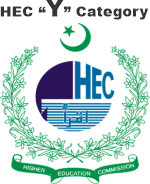MAJOR CHALLENGES FOR MEDIA EMPLOYEES IN PAKISTAN: DISPARITY OF RESOURCES BETWEEN MALE AND FEMALE JOURNALISTS
Keywords:
Working Conditions, Journalists & Media Organizations, Challenges, Gender, PakistanAbstract
This study presents the working conditions of media employees in Pakistan and the problems being faced by them. The study questions were targeted to answer the overall level of job satisfaction for working conditions in general and across media organizations as perceived by male and female journalists. Furthermore, the study examined the status of women journalists in media organizations of Pakistani focusing on their position and dignity level in media houses, opportunities for their career growth, and hindrances created in their prosperity in terms of discrimination or harassment, their career advancement, and the role that harassment and discrimination play in professional attainment. It finds that society's distinct individuals are based on gender. Thisa stratiifcation cause inqueality especially unequal distrbtion of power among media personals. Gender as a normative ideal is defined by the nature of media organizations and the hierarchy of power that exists within media organizations. Pakistan, as a patriarchal society, is still facing the hardships of gender disparity. Primarily the study is focused on exploring numbers and, more critically, where the women are and how they perform their journalistic duties with the challenges they confront and making progress in their careers. The study is conducted through a web survey engaging male and female journalists working in newspaper and electronic media organizations across Pakistan. The research design used was a 'convergent parallel mixed method' with a pragmatic worldview. Overall, a sample of 200 media persons from both genders was collected for the study.
Downloads
References
AlAashry, M. S. (2020). A critical analysis of journalists’ freedom of expression and access to information while reporting on COVID-19 issues: A case of selected Arab countries. 21.
Ali, S., Habes, M., Youssef, E., & Al Adwan, M. N. (2021). A Cross-Sectional Analysis of Digital Library Acceptance, and Dependency during Covid-19. International Journal of Computing and Digital Systems, 10(1), 1415–1425. https://doi.org/10.12785/ijcds/1001125
Ali, Z., & Bhaskar, S. B. (2016). Basic statistical tools in research and data analysis. Indian Journal of Anaesthesia, 60(9), 662–669. https://doi.org/10.4103/0019-5049.190623
Allern, S., & Pollack, E. (2019). Journalism as a public good: A Scandinavian perspective. Journalism, 20(11), 1423–1439. https://doi.org/10.1177/1464884917730945
Anwar Pasha, S., Youssef, E., & Sharif, H. (2021). Role of Virtual Reality in Improving Students’ LMS Experiences: Structural Equation Modelling Based Study (p. 7). https://doi.org/10.1109/MTICTI53925.2021.9664769
Appiah, B., Poudyal, A., Anum, D. A., Appiah, G., Wesuta, A. C., Akodwaa-Boadi, K., Ogodo, O., Nakkazi, E., Mulogo, E. M., & Odai, S. N. (2020). Challenges and facilitators of public engagement with water, sanitation, hygiene and other environmental health issues in Ghana and Uganda: Perspectives of scientists, journalists and the public. Journal of Water, Sanitation and Hygiene for Development, 10(1), 16–26. https://doi.org/10.2166/washdev.2019.019
Auverset, L. A., & Billings, A. C. (2016). Relationships Between Social TV and Enjoyment: A Content Analysis of The Walking Dead ’s Story Sync Experience. Social Media + Society, 2(3), 205630511666217. https://doi.org/10.1177/2056305116662170
Bielik, P., & Višňovský, J. (2021). Explanatory Journalism – A New Way How To Communicate In Digital Era. 4(1), 14.
Binns, A. (2017). Fair game? Journalists’ experiences of online abuse. Journal of Applied Journalism & Media Studies, 6(2), 183–206. https://doi.org/10.1386/ajms.6.2.183_1
Borger, M., van Hoof, A., & Sanders, J. (2016). Expecting reciprocity: Towards a model of the participants’ perspective on participatory journalism. New Media & Society, 18(5), 708–725. https://doi.org/10.1177/1461444814545842
Boyles, J. L., & Meyer, E. (2018). Letting the Data Speak. Digital Journalism, 4(7), 944–954. https://doi.org/10.1080/21670811.2016.1166063
Broussard, R. (2020). “Stick to Sports” is Gone: A Field Theory Analysis of Sports Journalists’ Coverage of Socio-political Issues. Journalism Studies, 21(12), 1627–1643. https://doi.org/10.1080/1461670X.2020.1785323
Burton, K. (2017). A Study of Motivation: How to Get Your Employees Moving.
Campbell, K. (2022). Journalism, Literature and Modernity: From Hazlitt to Modernism. In Journalism, Literature and Modernity. Edinburgh University Press. https://doi.org/10.1515/9781474465601
Chang, L. A. (2010). Work motivation and journalists in Taiwan and the US: an integration of theory and culture: Asian Journal of Communication: Vol 20, No 1. https://www.tandfonline.com/doi/abs/10.1080/01292980903440814
Chiat, L. C., & Panatik, S. A. (2019). Perceptions of Employee Turnover Intention by Herzberg’s Motivation-Hygiene Theory: A Systematic Literature Review. Journal of Research in Psychology, 1(2), Article 2. https://doi.org/10.31580/jrp.v1i2.949
Chin, W. W. (2012). Assessing Common Method Bias: Problems with the ULMC Technique on JSTOR. 36(3). https://www.jstor.org/stable/41703491
Cohen, L., & Manion, L. (2017). Action research | 22 | v8 | Research Methods in Education | Louis Cohe. In Research Methods in Education. https://www.taylorfrancis.com/chapters/edit/10.4324/9781315456539-22/action-research-louis-cohen-lawrence-manion-keith-morrison
Dernbach, B., & Illg, B. (2020). Journalism and Journalism Education in Developing Countries: , Published by Manipal Universal Press. Manipal Universal Press.
DušanićGačić, S., & Jovanović, S. (2017). Satisfaction of a Journalist With His Job. 4.
Endres, T. G. (2017). The Image of Impact in Literature, Media, and Society: 2020 SASSI Conference Proceedings. 94.
Ferreira, G. B. (2018). Gatekeeping Changes in the New Media Age: The Internet, Values and Practices of Journalism. Brazilian Journalism Research, 14(2), 486–505. https://doi.org/10.25200/BJR.v14n2.2018.1026
Flores, M. de los Á. (2013). Assessing the Job Satisfaction of U.S. Latino Journalists. 8(4). https://www.tandfonline.com/doi/abs/10.1080/17512786.2013.849847
Franks, S. (2013). Women and journalism. Published by I.B. Tauris & Co. Ltd in association with the Reuters Institute for the Study of Journalism, University of Oxford.
Gibson, T. A., Craig, R. T., Harper, A. C., & Alpert, J. M. (2016). Covering global warming in dubious times: Environmental reporters in the new media ecosystem. Journalism, 17(4), 417–434. https://doi.org/10.1177/1464884914564845
Golan, O., & Mishol-Shauli, N. (2020). Fundamentalist web journalism: Walking a fine line between religious ultra-Orthodoxy and the new media ethos. European Journal of Communication, 33(3), 304–320. https://doi.org/10.1177/0267323118763928
Habes, M., Elareshi, M., Mansoori, A., Pasha, S., Salloum, S. A., & Al-Rahmi, W. M. (2023). Factors Indicating Media Dependency and Online Misinformation Sharing in Jordan. Sustainability, 15(2), 1474. https://doi.org/10.3390/su15021474
Henseler, J., Ringle, C. M., & Sarstedt, M. (2014). A new criterion for assessing discriminant validity in variance-based structural equation modeling. Journal of the Academy of Marketing Science, 43(1), 115–135. https://doi.org/10.1007/s11747-014-0403-8
Hess, K., & Gutsche, R. E. (2022). Journalism and the “Social Sphere”: Reclaiming a foundational concept for beyond politics and the public sphere. Journalism Studies, 19(4), 483–498. https://doi.org/10.1080/1461670X.2017.1389296
Hosami, B., Jokela, P., & Mirijamdotter, A. (2019). Digital gender divide and empowering women in the digital age. 66.
Jeljali, R., Al Naji, L., & Khazam, K. (2018). A Comparison Between Moodle, Facebook, and Paper-based Assessment Tools: Students’ Perception of Preference and Effect on Performance. International Journal of Emerging Technologies in Learning (IJET), 13(05), 86. https://doi.org/10.3991/ijet.v13i05.8091
Kashyap, G., Bhaskaran, H., & Mishra, H. (2020). “We need to find a revenue model”: Data journalists’ perceptions on the challenges of practicing data journalism in India. Observatorio (OBS*), 14(2). https://doi.org/10.15847/obsOBS14220201552
Kennedy, L. G., Kichler, E. J., Seabrook, J. A., Matthews, J. I., & Dworatzek, P. D. N. (2019). Validity and Reliability of a Food Skills Questionnaire. Journal of Nutrition Education and Behavior, 51(7), 857–864. https://doi.org/10.1016/j.jneb.2019.02.003
Kircaburun, K., Alhabash, S., Tosuntaş, Ş. B., & Griffiths, M. D. (2020). Uses and Gratifications of Problematic Social Media Use Among University Students: A Simultaneous Examination of the Big Five of Personality Traits, Social Media Platforms, and Social Media Use Motives. International Journal of Mental Health and Addiction, 18(3), 525–547. https://doi.org/10.1007/s11469-018-9940-6
Kotisova, J. (2020). The elephant in the newsroom: Current research on journalism and emotion. Sociology Compass, 13(5), e12677. https://doi.org/10.1111/soc4.12677
Kumari, S. (2019). Empowerment of Women Journalists through Technology in Rural Areas of India. 10.
Laor, T. (2022). Twitter as a clique: Journalists’ patterns of Twitter use in Israel. Online Information Review, 46(1), 40–58. https://doi.org/10.1108/OIR-07-2020-0324
Lee, H.-W. (2018). Moderators of the Motivational Effects of Performance Management: A Comprehensive Exploration Based on Expectancy Theory—Hyung-Woo Lee, 2019. https://doi.org/10.1177/0091026018783003
Lin, J.-S., Sung, Y., & Chen, K.-J. (2016). Social television: Examining the antecedents and consequences of connected TV viewing. Computers in Human Behavior, 58, 171–178. https://doi.org/10.1016/j.chb.2015.12.025
MacKenzie, S. B., & Podsakoff, P. M. (2012). Common Method Bias in Marketing: Causes, Mechanisms, and Procedural Remedies. Journal of Retailing, 88(4), 542–555. https://doi.org/10.1016/j.jretai.2012.08.001
Mazouz, A., Alnaji, L., Jeljeli, R., & Al-Shdaifat, F. (2019a). Innovation and entrepreneurship framework within the Middle East and North Africa region. African Journal of Science, Technology, Innovation and Development, 11(6), 699–710. https://doi.org/10.1080/20421338.2019.1573959
Mazouz, A., Alnaji, L., Jeljeli, R., & Al-Shdaifat, F. (2019b). Innovation and entrepreneurship framework within the Middle East and North Africa region. African Journal of Science, Technology, Innovation and Development, 11(6), 699–710. https://doi.org/10.1080/20421338.2019.1573959
National Press Club Pakistan. (2023). National Press Club Islamabad | Venues | CPDI. https://www.cpdi-pakistan.org/events/venues/press-club
Nimri, M. (2017). Applying the Expectancy Theory to Explain the Motivation of Public Sector Employees in Jordan. https://platform.almanhal.com/Details/Articles/73661?lang=en
Novak, A. R., Impellizzeri, F. M., Garvey, C., & Fransen, J. (2021). Implementation of path analysis and piecewise structural equation modelling to improve the interpretation of key performance indicators in team sports: An example in professional rugby union. Journal of Sports Sciences, 39(22), 2509–2516. https://doi.org/10.1080/02640414.2021.1943169
Nwanne, B. U. (2016). JOURNALISM AND NEW MEDIA IN NIGERIA: ISSUES, CHALLENGES AND PROSPECTS. 4(3), 7.
Park, S., & Kim, S. (2017). The Linkage Between Work Unit Performance Perceptions of U.S. Federal Employees and Their Job Satisfaction: An Expectancy Theory. Transylvanian Review of Administrative Sciences, 13(52), 77–93. https://doi.org/10.24193/tras.52E.5
Pasha, S. A., Youssef, E., & Sharif, H. (2021). Role of Virtual Reality in Improving Students’ LMS Experiences: Structural Equation Modelling Based Study. 2021 International Conference of Modern Trends in Information and Communication Technology Industry (MTICTI), 1–7. https://doi.org/10.1109/MTICTI53925.2021.9664769
Posetti, J., & Storm, H. (2018). 7. Violence Against Women Journalists – Online and Offline. 19.
Simons, M., Tiffen, R., Hendrie, D., Carson, A., Sullivan, H., Muller, D., & McNair, B. (2017). Understanding the civic impact of journalism: A realistic evaluation perspective. Journalism Studies, 18(11), 1400–1414. https://doi.org/10.1080/1461670X.2015.1129284
Šimunjak, M., & Menke, M. (2022). Workplace well-being and support systems in journalism: Comparative analysis of Germany and the United Kingdom. https://doi.org/10.1177/14648849221115205
Suciu, L. E., Mortan, M., & Lazar, L. (2013). Vroom’s Expectancy Theory. An Empirical Study: Civil Servant’s Performance Appraisal Influencing Expectancy. Transylvanian Review of Administrative Sciences, 9(39), 180–200.
Syahputra, I., & Ritonga, R. (2019). Citizen Journalism and Public Participation in the Era of New Media in Indonesia: From Street to Tweet. Media and Communication, 7(3), 79–90. https://doi.org/10.17645/mac.v7i3.2094
Tahat, K. M., Habes, M., & Tahat, D. N. (2020). Towards Employing New Media in Journalism Major: A Cross Sectional Study at Yarmouk University, Jordan. 19.
Thompson Reuters. (2021). Thomson Reuters gives employees second mental health day off and signs the Mindful Business Charter. https://www.thomsonreuters.com/en/careers/careers-blog/thomson-reuters-gives-employees-second-mental-health-day-off-and-signs-the-mindful-business-charter.html
Thorsen, E. (2019). Surveillance of Journalists/Encryption Issues. In T. P. Vos, F. Hanusch, D. Dimitrakopoulou, M. Geertsema-Sligh, & A. Sehl (Eds.), The International Encyclopedia of Journalism Studies (1st ed., pp. 1–7). Wiley. https://doi.org/10.1002/9781118841570.iejs0272
Tiede, R. M. (2019). THE IMPORTANCE OF TRAVEL JOURNALISM. 38.
Velmurugan, T. A., & Sankar, D. J. G. (2017). A Comparative Study on Motivation Theory with Maslow’s Hierarchy theory and Two factor theory in Organization. 1(1).
Wahl-Jorgensen, K., & Pantti, M. (2021). Introduction: The emotional turn in journalism. Journalism, 22(5), 1147–1154. https://doi.org/10.1177/1464884920985704
Winarnita, M., Bahfen, N., Mintarsih, A. R., Height, G., & Byrne, J. (2022). Gendered Digital Citizenship: How Indonesian Female Journalists Participate in Gender Activism. Journalism Practice, 16(4), 621–636. https://doi.org/10.1080/17512786.2020.1808856

Downloads
Published
Issue
Section
License
Copyright (c) 2024 PAKISTAN ISLAMICUS (An International Journal of Islamic & Social Sciences)

This work is licensed under a Creative Commons Attribution 4.0 International License.
This work is licensed under a Creative Commons Attribution 4.0 International License.
































